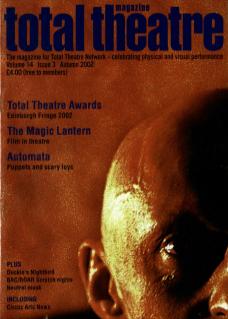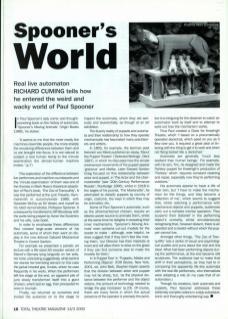In Paul Spooner's slyly comic and thought-provoking book on the history of automata, Spooner's Moving Animals (Virgin Books, 1986), he states:
'It seems to me that the more nearly the machines resemble people, the more sharply the remaining differences between them and us are brought into focus. It is not natural to subject a real human being to the minute examination the almost-human machine invites.' (p.7)
This exploration of the difference between live performers and machine counterparts and the 'minute examination’ of them was one of the themes in Mark Ross' theatrical adaptation of Paul's book, The Zoo of Tranquillity. It was first performed at the Lyric Theatre, Hammersmith in autumn/winter 1989, with Sylvester McCoy as Sir Vester, and myself as his robot demonstrator, Professor Spooner. It subsequently transferred to Off-Broadway with the parts being played by Avner the Eccentric and his wife, Julie Goell.
In order to emphasise these differences Paul created large-scale versions of his automata, some of which then went on display in the now defunct Cabaret Mechanical Theatre in Covent Garden.
For example we presented a parodic art lecture with a life-sized 3D wooden version of Manet's Olympia lying languidly on her sofa, her torso undulating suggestively, while behind her stands her trembling servant (in this case the jackal-headed god, Anubis, whom he uses frequently in his work). When the performers left the stage at the end, an apparent pile of junk slowly transformed itself into a giant chicken, which laid an egg, then proceeded to crow in triumph.
Finally, we returned as ourselves and invited the audience on to the stage to inspect the automata, which they did seriously and reverentially, as though at an art exhibition.
The illusory reality of puppets and automata and their relationship to how they operate mechanically has fascinated many practitioners and writers.
In 1802, for example, the German poet Heinrich von Kleist published an essay, 'About the Puppet Theatre' (Selected Writings, Dent 1997), in which he discusses how the simple mechanical movements of the puppet appear 'gracious' and lifelike. Later Edward Gordon Craig focused on this relationship between actor and puppet, in ‘The Actor and the Ubermarionette' (see 20th Century Performance Reader, Routledge 1996), whilst in 1918 in the pages of his journal, ‘The Marionette', he attempted to classify puppets by country of origin, costume, the ways in which they may be animated, etc.
Some of Paul Spooner's automata, such as the aforementioned chicken, require an electric power source to animate them, whilst at the same time he delights in revealing their inner mechanisms. Spooner's Moving Animals even contains cut-out models for the reader to make – although, ever helpful, he does suggest that if they don't feel like making them, 'our Director has their interests at heart and will allow them to relax on the grass if they can find someone else to make the models for them’.
In ‘A Puppet Tree' in Puppets, Masks and Performing Objects (TDR Books, New York, 2001, ed. John Bell), Stephen Kaplin asserts that the division between actor and puppet may not be sharp, but, 'as the physical distance between the performer and the object widens, the amount of technology needed to bridge the gap increases' (p.23). Of course, there are many forms in which the actual presence of the operator is precisely the point, but it is intriguing for the observer to watch an automaton work by itself and to attempt to work out how the mechanism works.
Thus Paul created a Dodo for Kneehigh Theatre, which 'I based on a pneumatically operated deckchair, which peed on you as it flew over you. It required a great deal of tinkering with the thing to get it to work and when not flying looked like a deckchair.’
Automata are generally 'much less resilient than human beings’. For example, with his son, Tim, he designed and made the Fishboy puppet for Kneehigh's production of Fishboy which requires constant cleaning and repair, especially now they're performing outdoors.
His automata appear to have a life of their own, but ‘I have to make the mechanism for the things, and they become a reflection of me', which seems to suggest that, whilst watching a performance with mechanical objects and puppets, audiences carry out a complex mental operation. They Suspend their disbelief in the performing object's unreality, whilst simultaneously recognising that, however distant, there is an operator and a creator without which the puppet cannot live.
Amongst other things, The Zoo of Tranquillity was a series of visual and psychological puzzles and puns about the real and the ideal. What had been performing objects during the performance, at the end became still sculptures. The audience had to make that shift in their perceptions, as they had to in comparing the apparently life-like automata with the real-life performers, who themselves were adopting a role (in my case that of an automaton.)
Through his creations, both automata and puppets, Paul Spooner addresses these extremely complex notions in a slyly subversive, ironic and thoroughly entertaining way.

